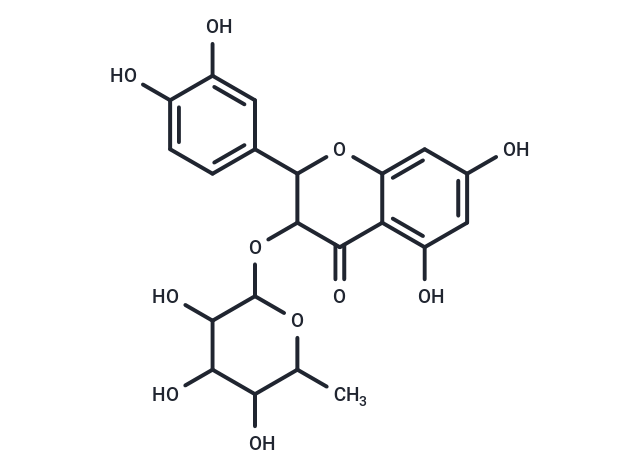Shopping Cart
- Remove All
 Your shopping cart is currently empty
Your shopping cart is currently empty

Isoastilbin is a dihydroflavonol glycoside compound found in Rhizoma Smilacis glabrae and Astragalus membranaceus. Isoastilbin inhibits glucosyltransferase (GTase) with an IC50 value of 54.3 μg/mL and possesses anti-acne and tyrosinase inhibition properties. Additionally, isoastilbin demonstrates neuroprotective, antioxidation, antimicrobial, and anti-apoptotic properties, indicating potential for Alzheimer's disease research.

| Pack Size | Price | Availability | Quantity |
|---|---|---|---|
| 1 mg | $129 | In Stock | |
| 5 mg | $347 | In Stock | |
| 10 mg | $515 | In Stock | |
| 25 mg | $823 | In Stock | |
| 50 mg | $1,090 | In Stock | |
| 100 mg | $1,490 | In Stock | |
| 1 mL x 10 mM (in DMSO) | $429 | In Stock |
| Description | Isoastilbin is a dihydroflavonol glycoside compound found in Rhizoma Smilacis glabrae and Astragalus membranaceus. Isoastilbin inhibits glucosyltransferase (GTase) with an IC50 value of 54.3 μg/mL and possesses anti-acne and tyrosinase inhibition properties. Additionally, isoastilbin demonstrates neuroprotective, antioxidation, antimicrobial, and anti-apoptotic properties, indicating potential for Alzheimer's disease research. |
| Targets&IC50 | GTase:54.3 μg/mL (IC50) |
| In vitro | The crude extracts were assayed for antimicrobial activities against Streptococcus sobrinus and for glucosyltransferase (GTase) inhibition. Fourteen extracts inhibited the growth of S. sobrinus by more than 50% and six extracts inhibited GTase activity by more than 50% at a concentration of 100 μg/ml. Koompassia malaccensis (kempas) extracts showed 90% depression of S. sobrinus growth and 80% inhibition of GTase activity at a concentration of 100 μg/ml. Kempas crude extracts were subjected to column chromatography using Sephadex LH-20 and then preparative high-performance liquid chromatography to isolate four compounds A, B, C, and D. These compounds were identified as taxifolin and the flavanonol rhamnoside isomers neoastilbin, astilbin, and Isoastilbin, respectively, from 1H and 13C nuclear magnetic resonance (NMR) spectra and other two-dimensional NMR techniques (COSY, HMBC, and HMQC). Each compound depressed the growth of S. sobrinus over a concentration range of 9.3242.7 μg/ml and showed GTase inhibitory activity with IC50 values in the range 27.4-57.3 μg/ml[1] |
| Molecular Weight | 450.39 |
| Formula | C21H22O11 |
| Cas No. | 54081-48-0 |
| Smiles | CC1OC(OC2C(Oc3cc(O)cc(O)c3C2=O)c2ccc(O)c(O)c2)C(O)C(O)C1O |
| Relative Density. | 1.74 g/cm3 (Predicted) |
| Storage | Powder: -20°C for 3 years | In solvent: -80°C for 1 year | Shipping with blue ice. | ||||||||||||||||||||||||||||||
| Solubility Information | DMSO: 25 mg/mL (55.51 mM) | ||||||||||||||||||||||||||||||
Solution Preparation Table | |||||||||||||||||||||||||||||||
DMSO
| |||||||||||||||||||||||||||||||

Copyright © 2015-2024 TargetMol Chemicals Inc. All Rights Reserved.